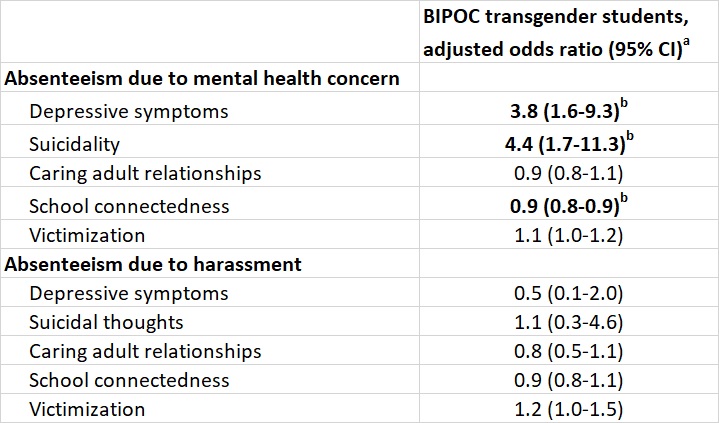Adolescent Medicine: General
Adolescent Medicine 3
515 - School Absenteeism among Black, Indigenous, and People of Color transgender high school students and their peers
Publication Number: 515.3
- AC
Anita Chaphekar, DO (she/her/hers)
Clinical Fellow
University of California, San Francisco, School of Medicine
San Francisco, California, United States
Presenting Author(s)
Background:
School absenteeism has been tied to mental health conditions and other psychosocial factors. Studies have shown that transgender students have high rates of harassment, mental health concerns, and absenteeism compared to cisgender peers. Absenteeism due to mental health concerns or due to harassment have not been studied in Black, Indigenous, and People of Color (BIPOC) transgender high school students.
Objective:
The primary objective of this study is to compare absenteeism due to harassment and mental health concerns between BIPOC transgender youth and the following peer groups: White transgender youth, BIPOC cisgender youth, and White cisgender youth. A secondary objective is to examine potential protective factors and risk factors for absenteeism due to mental health concerns and harassment for BIPOC transgender youth.
Design/Methods: 2017-2019 Biennial California Healthy Kids Survey data was analyzed with a weighted sample of the state's secondary school population. For the two measures of absenteeism, survey questions asked students if they had missed school in the past 30 days due to mental health concerns or harassment. Logistic regression analyses compared absenteeism between peer groups while controlling for demographic covariates. For BIPOC transgender youth, associations between forms of absenteeism and psychosocial factors were assessed via logistic regression.
Results:
Table 1 shows estimated prevalence of demographic factors, absenteeism, and mental health symptoms and estimated means for continuous school-based psychosocial measures by peer group. As demonstrated in Table 2, BIPOC transgender and White transgender students had similar odds of both forms of absenteeism. BIPOC transgender students had higher odds of being absent from school due to mental health concerns and harassment compared to White cisgender students and BIPOC cisgender students. As shown in Table 3, depressive symptoms and suicidality are associated with higher odds of absenteeism due to mental health concerns for BIPOC transgender students (adjusted odds ratio 3.8, 95% CI [1.6-9.3] and 4.4, 95% CI [1.7-11.3], respectively). School connectedness is associated with lower odds of absenteeism due to mental health concerns for BIPOC transgender students (adjusted odds ratio 0.9, 95% CI 0.81 to 0.97).
Conclusion(s):
BIPOC transgender students report higher rates of school absenteeism due to mental health concerns and harassment compared to cisgender students. Addressing factors associated with absenteeism is a critical step in formulating school- and clinic-based interventions that promote attendance among these students..jpg)


